The week at a glance
- Short-toed Treecreeper in Suffolk
- White-winged Scoter still in Co Kerry
- Pied-billed Grebe still in Argyll
- Oriental Turtle Dove still in Oxfordshire
- House Crow still in Co Cork
- White-tailed Eagle relocated in East Anglia
With a perfect high-pressure system stretching across most of Britain and into southern Europe, coupled with a strong tailwind, the week was always going to be a good one for migrants, and it didn't fail to impress.
Last week's Short-toed Treecreeper remained at Landguard Bird Observatory (Suffolk) all week but was rather elusive at times. The site also held up to three Black Redstarts and a Firecrest to keep the crowds happy. Most of the other quality birds also stayed into this week: the White-winged Scoter was off Rossbeigh (Co Kerry) to at least 4th, with a great supporting cast of a female Surf Scoter on 2nd and a probable White-billed Diver on 3rd. The latter may well be the bird that was off Cromane at the end of March — the second for Co Kerry. The Pied-billed Grebe was reported from Salen, Mull (Argyll) on 3rd and 6th, but this too is elusive. The Oriental Turtle Dove continued to show in the gardens of Chipping Norton (Oxon) and the resident House Crow also remained in Cobh (Co Cork).
Both of last week's Snow Geese were reported again this week; at Laxfirth (Shetland) until at least 3rd and in Co Antrim one was back at Portmore on 31st–3rd. As usual, there were more Ross's Geese reported, with the same four birds still at Doddington (Northumberland) to 2nd, Dowlaw (Borders) to 3rd, Loch Leven (Perth & Kinross) on 3rd and at Rockcliffe Marsh (Cumbria) on 3rd. There was also an escapee at Upware (Cambs) on 3rd.

Snow Goose, Portmore Lough RSPB, Antrim (Photo: Ed O'Hara)
The only Black Brant now remaining was at Wexford Wildfowl Reserve on 3rd, along with a late Tundra Bean Goose. The only Red-breasted Goose was again at Vane Farm (Perth & Kinross) all week and the only other goose of note was the Lesser Canada Goose still at Malin Head (Co Donegal) all week.

Red-breasted Goose, Vane Farm RSPB, Perth & Kinross (Photo: John Nadin)
Neither of the East Anglian Ferruginous Ducks was reported this week, but the drake was at Chew Valley Lake (Somerset) to at least 1st, and a very smart new drake was at Lydiard Park, Swindon (Wiltshire). This was reported on 1st, but had been present since the end of March, and is staying put despite the disturbance caused by photographers. This is the ninth for the county, but the fourth since 2000.

Ferruginous Duck, Swindon, Wiltshire (Photo: Graham Cox)
Apart from the drake still at Stithians Reservoir (Cornwall) all week, all the remaining Ring-necked Ducks were in Ireland. In Co Cork a drake was at Lough Aderra on 2nd–6th and a smart female was in Cork City on 2nd–3rd, and a drake was at Inch Island Lake (Co Donegal) on 5th. Equally brief was a drake at Oxford Island (Co Armagh) on 3rd, and another was at Castleward (Co Down) on 31st–2nd.

Ring-necked Duck, Castleward, Down (Photo: Craig Nash)
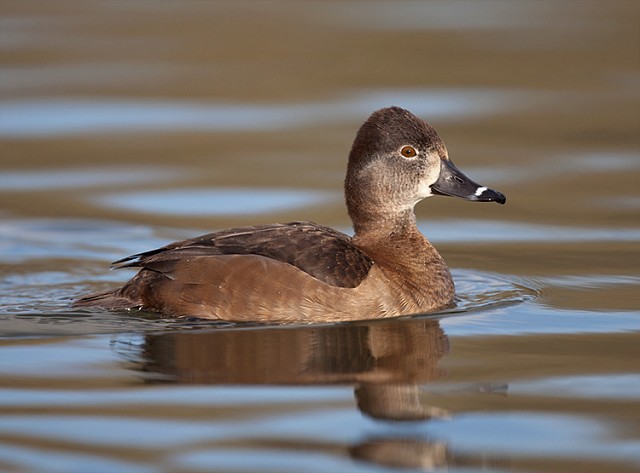
Ring-necked Duck, Cork City, Cork (Photo: Graham Clarke)
The number of Green-winged Teal really dropped this week, with just three birds reported. These were the remaining birds at Cresswell Pond (Northumberland) on 2nd, Peterstone Wentlooge (Gwent) to 4th and Tacumshin (Co Wexford) again on 3rd. There was just a single record of Blue-winged Teal, a very brief bird on the Ouse Washes (Cambs) on the evening of 1st. There was also just one American Wigeon, the drake remaining at Cresswell Pond (Northumberland) to 1st. There were rather more Lesser Scaup reported: the long-staying birds were still at Slimbridge (Glos) and Marshside RSPB (Lancs), and the drake in Cardiff Bay (Glamorgan) was reported again on 2nd.
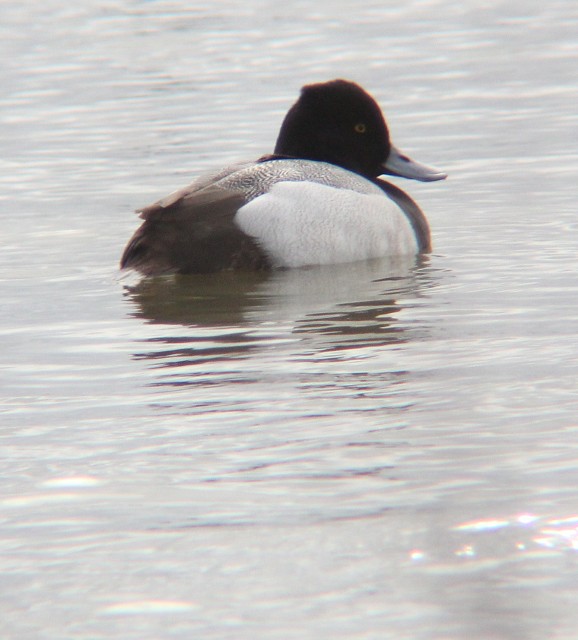
Lesser Scaup, Marshside RSPB, Lancashire (Photo: Graham Johnson)
With no report of the Dawlish Surf Scoter, just two drakes remained: in Liscannor Bay (Co Clare) on 2nd and off Rerwick Head (Orkney) on 2nd–6th. There were similarly few reports of rare eiders, all the remaining birds now in Scotland. Drake King Eiders remained in and around Uyeasound, Unst (Shetland) to 1st and on the Ythan estuary (Aberdeenshire) to 5th, and the only report of Northern Eider was one still in Stinky Bay, Benbecula (Outer Hebrides) on 2nd.
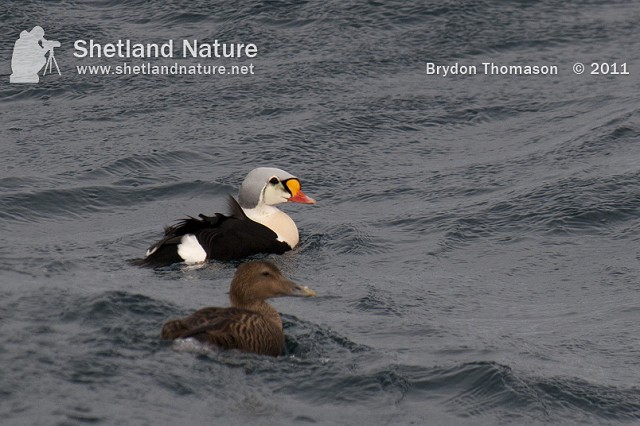
King Eider, Belmont, Unst, Shetland (Photo: Brydon Thomason)
Apart from the aforementioned possible in Co Kerry, the only White-billed Divers were two different birds off Tiree (Argyll) on 27th and 28th. Reports of Smew continued to decline, with birds recorded at just six sites now. The furthest south was a drake at Pugney's Country Park (West Yorks) on 1st–2nd, and the only other English bird was a redhead at Hurworth Burn Reservoir (Durham) on 3rd. A redhead remained at Quoile Pondage (Co Down) to 3rd, and in Scotland a drake and female remained at Lochwinnoch (Strathclyde) to 4th, the redhead remained at Lindores Loch (Fife) to 4th and a new redhead was at Loch of Strathbeg (Aberdeenshire) on 1st.
With a good southerly wind you'd probably expect a few more interesting spring seabirds, but the only reports of Balearic Shearwaters were singletons past Portland (Dorset) on 1st and 6th. More interesting was a Leach's Storm-petrel at Theale Gravel Pits (Berks) on 1st.

Leach's Storm-petrel, Theale GPs, Berkshire (Photo: Phil Wallace)
As predicted, there was a small rush of Purple Herons from 2nd, with at least six birds arriving. The first flew in off the sea at Sennen (Cornwall) on 2nd, before landing near Land's End. It was then seen heading west over Drift Reservoir on 3rd and possibly the same was over College Reservoir on 6th. Also in the southwest, one was on St Mary's (Scilly) from 3rd–6th. A probable over New Fancy View (Glos) on 4th may have been the Cornish bird, and another was at Dwyran (Anglesey) on 5th–6th, the first on the island since 2007. In Norfolk, one at Waxham was unfortunately in an area with no general access. The only other bird was one over La Claire Mare (Guernsey) on 3rd.
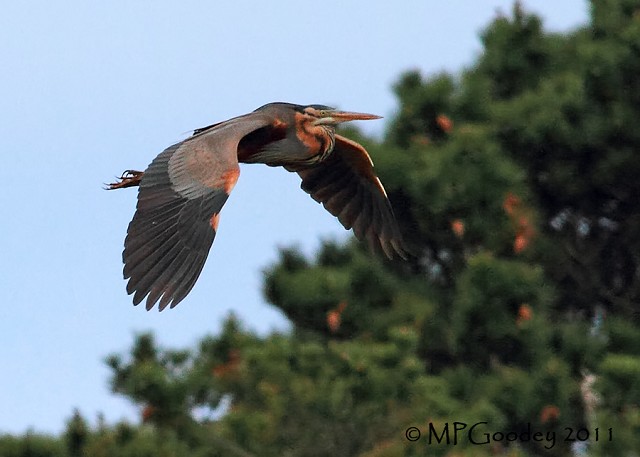
Purple Heron, St. Mary's, Isles of Scilly (Photo: Martin Goodey)
Apart from one reported at Rogate (West Sussex) on 31st, records of Great White Egret were all of flyover birds: at Frampton-on-Severn (Glos) on 2nd, Pulborough Brooks (West Sussex) on 3rd and Bayfield Brecks (Norfolk) on 5th. The Cattle Egret remained on Guernsey, seen at St Andrew's on 6th. Apart from one still at Loch of Strathbeg (Aberdeenshire) on 2nd–3rd, all Spoonbills were south of a line from The Wash to the Severn. These were all small groups, with three birds together at Elmley Marshes (Kent), Walmsley Sanctuary (Cornwall), Brading Marshes (Isle of Wight) and Lymington and Keyhaven Marshes (Hants).
Last week's run of White Storks was replaced by a run of Black Storks this week. One headed east over Porth Hellick, St Mary's (Scilly) on 2nd and another (or the same?) headed over Shapwick Heath (Somerset) on 3rd, later seen over Nettlebridge. This is only the fourth for the county, following two in 1993 and the first in 1814. There was then another over Lake Lothing (Suffolk) on 4th which possibly then headed over Sea Palling (Norfolk) on 6th. The only White Storks were also in Norfolk, with two reported over Hickling on 6th.
Away from East Anglia, where birds were reported from eight sites from Norfolk to Essex, the only Rough-legged Buzzards were over Gibraltar Point (Lincs) on 4th, over Pleasley Pit Country Park (Notts) on 6th and the wintering bird that remained at Toft (Shetland) all week. Having left Hampshire, the juvenile White-tailed Eagle managed to avoid a huge number of pairs of eyes before being seen heading eastwards over Little Cawthorpe (Lincs) at 12:44 on 3rd. It was next seen at Titchwell (Norfolk) at 14:56 the same day, which isn't bad going! It then drifted slowly along the north Norfolk coast before heading into Suffolk briefly at mid-day on 4th. It then flew back north and along the north Norfolk coast on 6th. By early afternoon it headed out over the Wash and was at Gibraltar Point (Lincs) by 15:25.

White-tailed Eagle, Corton, Suffolk (Photo: Andrew Easton)
Almost paling into insignificance with the above, the Cornish Golden Eagle was reported again, over Penzance on 4th. There were no reports of any of the Northern Harriers nor the possible Tundra Peregrine. Ospreys were very well spread across the country, with birds pretty much in all regions, although surprisingly there were none in Norfolk. Also fresh in was a female Red-footed Falcon circling over Willingham by Stow (Lincs) briefly on 6th, with possibly the same at Messingham Sand Quarry the same day.
The Spotted Crake remained at Brandon Marsh (Warks) all week.

Spotted Crake, Brandon Marsh NR, Warwickshire (Photo: Andy Hood)

Spotted Crake, Brandon Marsh NR, Warwickshire (Photo: Kath Everitt)
The Long-billed Dowitcher remained at Lodmoor (Dorset) all week. A nice spring wader was a male Kentish Plover on the beach at Pegwell Bay (Kent) for just 10 minutes on 5th, the fifth there in the last five years.
Glaucous Gulls were still present in small numbers at widespread coastal locations, with inland birds at Calvert Lakes (Bucks) and Grafham Water (Cambs) and a probable second-winter at Marston Vale Millennium Country Park (Beds). Iceland Gulls were at more inland sites, in Bedfordshire, Derbyshire, West Yorkshire and Lancashire. There was also a juvenile at the unlikely location of Aviemore (Highland) on 1st. All were singles apart from two at Enniskillen (Co Fermanagh) on 31st. An adult Ring-billed Gull at Sennen Cove (Cornwall) was new in on 2nd–3rd, with other adults still at Dingwall (Highland) on 5th and Newnham (Glos) on 4th. In Ireland, two birds were at Nimmo's Pier (Co Galway) on 2nd with just one reported at Cuskinny Marsh (Co Cork) on 3rd. The Baltic Gull was again at Livermere Lakes (Suffolk) on 2nd. With no sign of the Welsh Bonaparte's Gulls, others included the adult again at Castletown (Highland) on 3rd–6th. There was also a first-winter at Gott Bay, Tiree (Argyll) on 4th–6th — only the second for Argyll following an adult on Islay in June and September 1975.
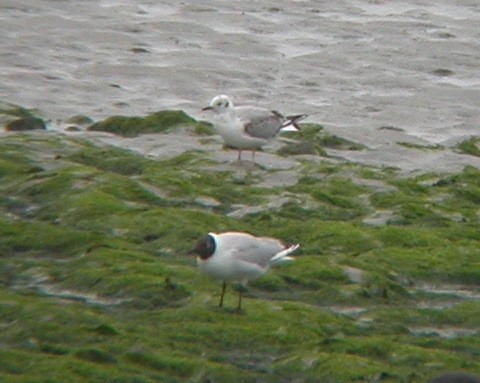
Bonaparte's Gull, Tiree, Argyll (Photo: John Bowler)
In was a good week for terns, with the first Whiskered Tern for the Outer Hebrides, an adult, at Loch Fada, Benbecula, on 5th. There are just five previous records in Scotland. There was then a Gull-billed Tern over ploughed fields near Sennen (Cornwall) on 6th. The first Arctic Tern of the year was one at Barton Broad (Norfolk) on 2nd.

Whiskered Tern, Loch Fada, Benbecula, Outer Hebrides (Photo: Steve Duffield)

Gull-billed Tern, Sennen, Cornwall (Photo: Brian Field)
With the first Cuckoos arriving as far north as Nottinghamshire, there was also a report of a Great Spotted Cuckoo from the unlikely location of Orpington (London) on 6th. It was classic swift weather this week, and common and rare alike turned up as predicted. The first Alpine Swift was over Cley Marshes (Norfolk) on 2nd, closely followed by birds at Flamborough (East Yorks) and Sands Cove (Co Cork) on 3rd. The 4th saw birds at Dunwich Heath (Suffolk), Harrogate (North Yorks) to 6th, and Ramsey (Isle of Man) to 5th. On the 6th birds were at Rathfarnham (Co Dublin) and Leiston (Suffolk). A very early Pallid Swift was also at Dungeness (Kent) briefly on 6th. There were also several Common Swifts, reported from sites as far north as Lothian and Orkney.

Alpine Swift, Ramsey, Isle of Man (Photo: B Callow)
Elusive as ever were spring Bee-eaters; one was over Fowey (Cornwall) on 2nd and then another or the same was at Windmill Farm (Cornwall) on 3rd. There was also one on St Mary's (Scilly) and a brief fly-over reported from Blakeney (Norfolk) on 3rd. Other typical spring fare came in the form of the first Wrynecks, with one on St Mary's (Scilly) on 2nd, one reported from Hurlstone Point (Somerset) the same day and one briefly in a garden in Tavistock (Devon) on 4th.
There were, surprisingly, still Shore Larks at a good number of sites, with up to 16 again at Gibraltar Point (Lincs) and 10 still at Cley Marshes (Norfolk). Small groups also remained in Kent, Suffolk and Lothian. One was still at Warton, near Carnforth (Lancs) on 3rd and a new bird was at Druridge Pools (Northumberland) on 5th–6th. In contrast, the first Short-toed Lark of the year was at Portland (Dorset) on 3rd–6th.
In the southwest, Hoopoes remained on Lundy (Devon) to 1st, at Morvah (Cornwall) to 3rd and on Portland (Dorset) to 4th, with one also still on Sherkin Island (Co Cork) on 2nd. The perfect spring migration weather produced a rush of birds from 2nd, with new arrivals at Prawle Point (Devon), Wembury (Devon), Newhaven (East Sussex), Bardsey Island (Gwynedd), Seaton (Cornwall), Sissinghurst (Kent), Skibbereen (Co Cork), Hove (East Sussex), Holton Heath (Dorset), Launceston (Cornwall), Gugh (Scilly) and Whitfield (Kent). Perhaps the most popular, though, was one at Crondall (Hants) on 4th–6th.

Hoopoe, Bardsey Island, Gwynedd (Photo: Steve Stansfield)
Considering the number of records of Red-flanked Bluetail last autumn, it perhaps wasn't surprising that a few might winter, and a bird at Durlston Country Park (Dorset) from 2nd to the week's end was presumably on return migration. This is only the second record for Dorset, following the legendary bird at Winspit in 1993 that was the first really twitchable bird. It is also only the fifth spring record, with only one earlier: at Easington (East Yorks) on 31st March 2007.
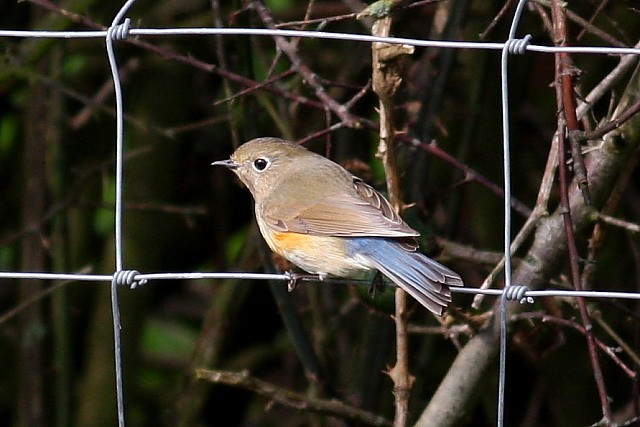
Red-flanked Bluetail, Durlston CP, Dorset (Photo: Peter Moore)
A more typical spring migrant is Red-rumped Swallow, and birds were reported from Lizard (Cornwall) briefly on 2nd, Tacumshin (Co Wexford) on 2nd and Swineham Point (Dorset) on 4th.
There were still good numbers of Waxwings reported across central and southern England, with scattered groups in central Scotland. The largest flocks reported were 130 in Stoke-on-Trent (Staffordshire), 120 still at West Thurrock (Essex), 119 in Poole (Dorset), 110 in Liverpool, 80 in Leith (Lothian) and 80 in Twickenham (London).
Early warbler interest came in the form of a fine male Western Subalpine Warbler at Humberston Fitties (Lincs) on 3rd, a possible singing Savi's Warbler at Louth (Lincs) on 3rd and another spring Yellow-browed Warbler, in a garden at Beverley (East Yorks) on 4th. There were also plenty of Grasshopper Warblers now in, and also the first Wood Warblers, at Berrow (Somerset) on 2nd and Weeley Heath (Essex) on 5th. Other new migrants included Nightingales along the south coast from 4th, Tree Pipits as far north as Lancashire from 5th and Blue-headed Wagtails at numerous sites from Suffolk to Dorset.

Western Subalpine Warbler, Humberston Fitties, Lincolnshire (Photo: Graham Catley)
Great Grey Shrikes remained at around 18 sites in England, two in Wales and two in Scotland, and Ireland's mega was again at Slievenacloy (Co Antrim) all week. The first-winter Rose-coloured Starling remained in Penzance (Cornwall) to at least 4th. Rather more summery shrikes were the two Woodchats on the Isles of Scilly, with a male on St Agnes on 4th–6th and a female on St Mary's on 6th.
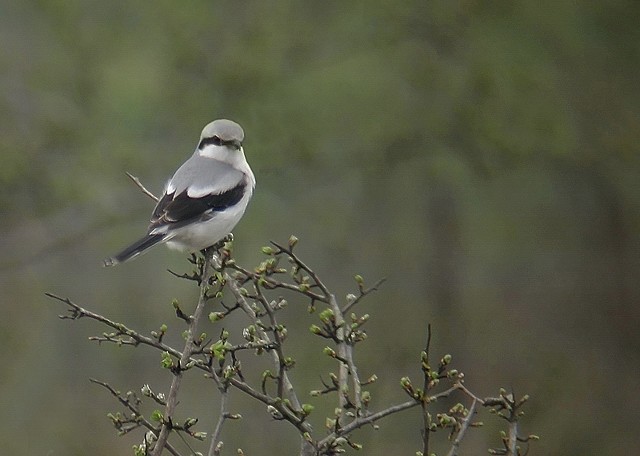
Great Grey Shrike, Slievenacloy NR, Antrim (Photo: Ronan McLaughlin)
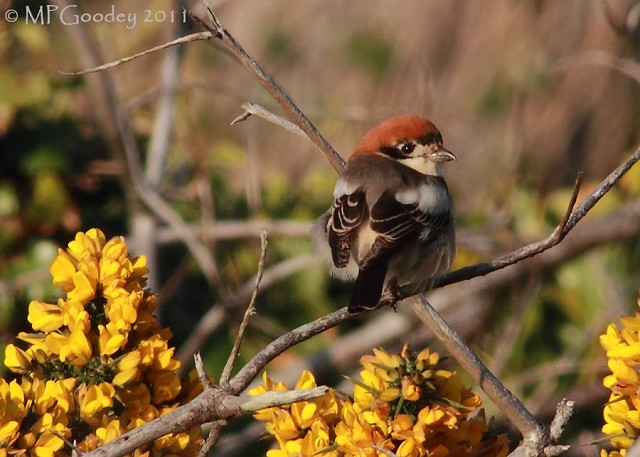
Woodchat Shrike, St. Mary's, Isles of Scilly (Photo: Martin Goodey)
After last week's first arrivals, further Serins included a female at North Foreland (Kent) on 2nd and a male at Dundeugh (Dumfries & Galloway) on 3rd, and flyovers reported from Ballyvergan Marsh (Co Cork) on 3rd and Pegwell Bay (Kent) on 4th.
Lapland Buntings continued to move north, with just one south-coast bird, at Pett Level (West Sussex) on 1st. Others were widespread along the coast, with 15 at Cowbar (Cleveland), 10 at Aird an Rùnair, North Uist (Outer Hebrides), 10 on North Ronaldsay (Orkney) and 10 at Carmel Head (Anglesey). The Central Asian Lesser Whitethroat remained in Drogheda (Co Louth) to at least 3rd and a Northern Bullfinch was reported at Sculthorpe Moor (Norfolk) on 3rd.
Photo of the Week: 31st March–6th April 2011
There is no Photo of the Week this week — we'll have two next week.

